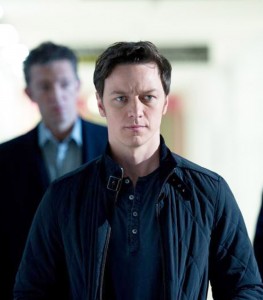Danny Boyle crafts mesmerizing thrill ride in Trance
Rarely does a director film a movie only to shelve the footage in order to work on a more high-profile project. After all, the filmmaking process is a costly and time-consuming endeavor that requires a singular focus.

Hypnotizing · Trance, the chilling film by acclaimed U.K. director Danny Boyle, focuses on an art auctioneer, Franck, played by Vincent Cassel, who gets mixed up with a criminal gang after suffering serious head trauma. – Courtesy of Greg Gayne
Yet when a filmmaker has received the level of praise and acclaim that director Danny Boyle has, traditional or ordinary never seem to apply.
Such was the case with Trance. After Boyle was selected as the director of the opening ceremony for the 2012 London Olympic Games, he worked seven-day weeks, spending five days on Trance and two days on ceremony development. Upon conclusion of principal photography for the film, he and his editor, Jon Harris, assembled an early rough cut and then let the film rest until late last year.
Distributed in limited release this April by frequent Boyle collaborator Fox Searchlight Pictures, Trance is a uniquely imagined story. Forced by a group of criminals, an art auctioneer attempts to uncover the location of a missing painting through hypnotic treatment. During the theft, the auctioneer, Simon (James McAvoy), suffers a blow to the head, causing amnesia.
In an attempt to stimulate his memory, he and the gang leader, Franck (Vincent Cassel), employ the services of hypnotherapy through Elizabeth (Rosario Dawson). A gripping tale of romance and suspense unfolds as the film delves deeper and deeper into Simon’s mind.
From a broad perspective, the narrative at the core of the film is quite simple. Three characters — Simon, Franck, and Elizabeth — dominate the script; every scene presents at least one as the focus. Yet, the film in its entirety is by no definition simple. Simon, Franck and Elizabeth are each written by screenwriters Joe Ahearne and John Hodge with multiple dimensions and rich development, leaving you constantly questioning the motives and moral alignment of the three central characters. Those who initially seem to be victimized hint at signs of wickedness in other scenes. The mired presentation of the characters’ principles allows the audience to be deeply engaged with the subject. The individual viewer acts as an additional external player in the story, deciphering the characters’ action just as the characters size each other up. Thus, you are left thinking and attempting to solve the film for yourself.
By enticing the audience to contemplate the film’s conclusion, Ahearne and Hodge intensify the effect of the script’s many twists and turns. Though unexpected story elements can often seem unrealistic or implausible, the sudden changes in Trance are enveloped in realism, for they are validated by the audience imaginative speculation.
But though the script is carefully constructed and frequently excellent, Ahearne and Hodge nearly complicate the story to a frantically convoluted level.
The divide between intriguing complexity and confusing complexity is highly permeable, making it easy for Ahearne and Hodge to overcomplicate from the film’s onset. Though most of the intricacy is added for useful dramatic effect, the film’s third act is written to emphasize the story’s twists. It appears as if their ideas for holding the audience’s attention and intrigue began to run thin as the film reaches its conclusion.
Yet any flaw in the script is combated by Boyle’s expectably superb directing. Look no further than the film’s opening heist scene: Many directors would follow convention and direct the sequence with a haphazard, overly energetic style. Boyle, on the other hand, injects stability into the action and immediately grounds the film to some extent in reality, albeit in a slightly hyper form. His tense direction is especially invaluable in this first scene as it is the topic of mystery discussed throughout the rest of film.
Boyle, in addition to pacing the action well presents the story in a manner that aids the audience’s thought processes. He carefully alludes to clues and hints at certain truths explained later in the film, and expertly provides the audience with enough information to gestate predictions in the viewers’ mind but holds back from spoiling the plot. In particular, the way he teases certain events really works to pull you even further into the film’s story.
The cinematography and set design of Trance seduce and allures, thanks to work from cinematographer Anthony Dod Mantle and production designer Mark Tildesley. Both utilize a wide palette of neon colors that jump off the screen and create a unique visual style.
Mantle’s camera movement in particular has a kinetic and hypnotic nature about it, which few recent films have achieved. Paired with Harris’s masterful editing, the aesthetics succeed at portraying Simon’s disorienting amnesia and Elizabeth’s spellbinding hypnotism. The detailed visuals bring the viewer further into the film, compelling more and more intellectual contemplation.
On the whole, Trance is one of the best films released thus far in 2013, as it truly lives it up to its title by enthralling the viewer in a complex tale much larger and more impactful than a mere art heist.
